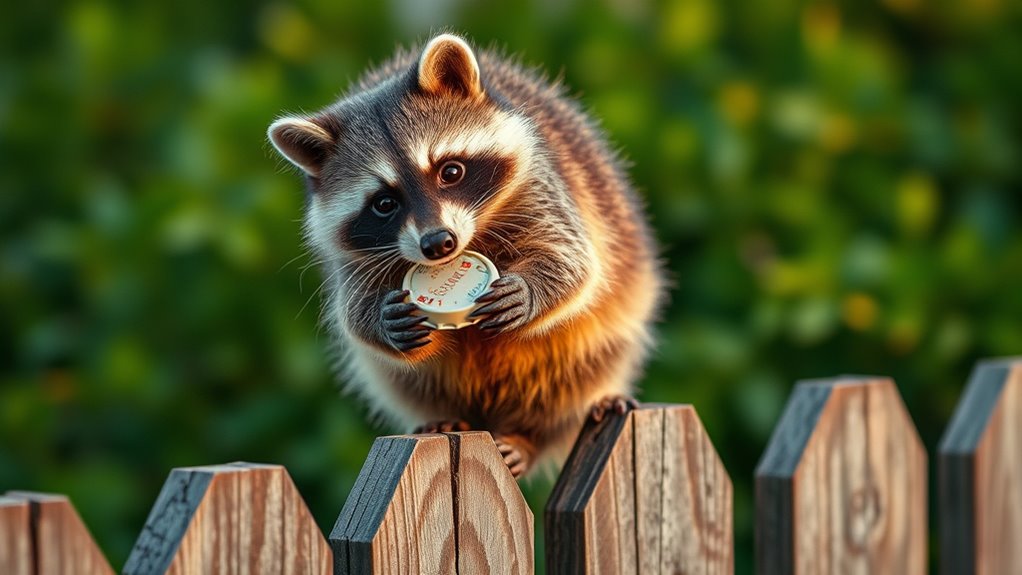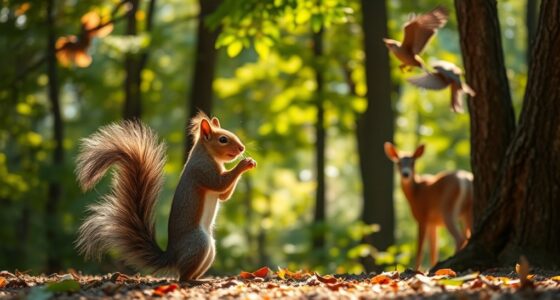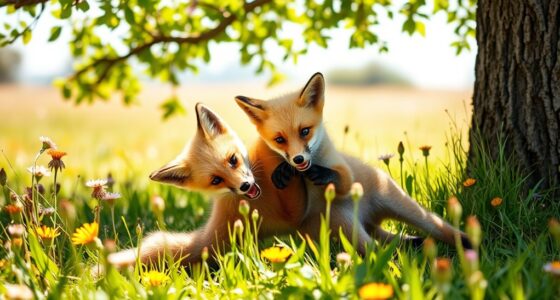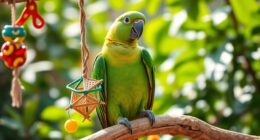Animal curiosity drives problem-solving skills across various species, revealing their intricate cognitive abilities. When animals explore new environments, they learn and adapt by evaluating risks and experimenting with different solutions. This behavior is often seen in pets and wild animals alike, leading to innovative tool use and complex interactions with their surroundings. By understanding how curiosity fosters cognitive growth, you’ll appreciate the deep connection between exploration and intelligence in the animal kingdom.
Key Takeaways
- Animal curiosity drives exploration and enhances cognitive development, demonstrating problem-solving abilities beyond basic survival needs.
- Environmental enrichment promotes mental stimulation, leading to complex behaviors and improved problem-solving skills in animals.
- Tool use in species like primates and birds indicates a sophisticated understanding of cause-and-effect relationships, stemming from curiosity-driven experimentation.
- Curiosity encourages risk assessment and adaptive behavior, enabling animals to learn from mistakes and thrive in varied environments.
- Stimulating environments foster natural curiosity, while barren settings can hinder cognitive growth and problem-solving capabilities in animals.
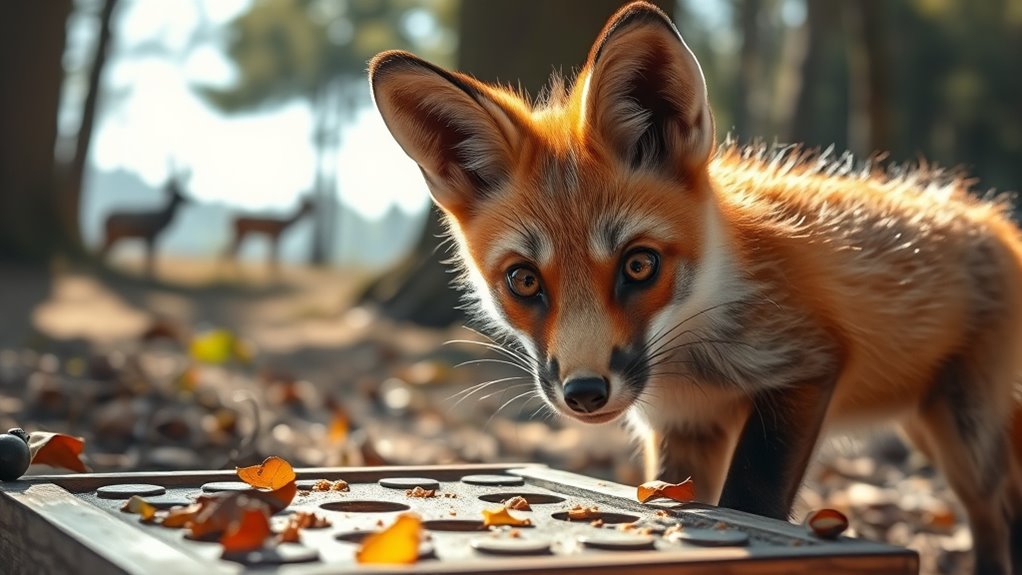
While many people view curiosity as a uniquely human trait, animals display an impressive range of inquisitive behaviors that highlight their problem-solving abilities. You may not realize it, but many species demonstrate a keen interest in exploring their surroundings, which plays a significant role in their cognitive development. This exploration isn’t just about finding food or shelter; it’s also about learning and adapting to their environment. When you observe animals interacting with novel stimuli, you’re witnessing a form of intelligence that’s often overlooked.
Take a moment to think about your pet. When a dog sniffs around the house or a cat bats at a new toy, they’re not just playing—they’re engaging in a critical process of discovery. This kind of environmental enrichment is essential for their mental stimulation. It helps them develop new skills and encourages creativity in problem-solving. You might notice that animals who experience a rich and stimulating environment tend to exhibit more complex behaviors and solutions to challenges they face.
Animals engage in discovery through play, enhancing their problem-solving skills and thriving in stimulating environments.
For example, studies have shown that primates, elephants, and even certain bird species can use tools. Imagine witnessing a chimpanzee fashioning a stick to fish for termites or a crow dropping stones into a container to raise the water level to access food. These actions indicate not just curiosity, but an understanding of cause and effect—a key aspect of cognitive development. When animals engage with their surroundings, they learn from their experiences, which enhances their problem-solving capabilities.
Moreover, curiosity drives animals to assess risks and rewards. When they encounter new objects or situations, they may experiment, testing boundaries and learning from mistakes. This trial-and-error approach is fundamental to their adaptive behavior. As you observe these interactions, it becomes clear that curiosity fuels the learning process, allowing animals to thrive in diverse environments. The use of tools by animals, for instance, mirrors human innovation and highlights the effectiveness of eye patches in enhancing their problem-solving skills.
You might also consider how a lack of environmental enrichment can stifle an animal’s cognitive growth. Animals in barren environments may exhibit signs of boredom or stress, which can hinder their ability to problem-solve effectively. By providing stimulating environments rich in opportunities for exploration, you can foster their natural curiosity and enhance their cognitive development.
In essence, curiosity in animals is more than a mere whim; it’s a crucial component of their survival and intelligence. As you appreciate the inquisitive behaviors of animals, you’ll gain a deeper understanding of the complex interplay between curiosity and problem-solving in the animal kingdom.
Frequently Asked Questions
How Can I Encourage Curiosity in My Pet?
You can encourage curiosity in your pet by engaging in playful interaction and providing enrichment activities. Try hiding treats around your home or using puzzle toys to stimulate their minds. Regularly change their toys and introduce new scents to keep things fresh. Spend time exploring different environments together, like parks or pet-friendly cafes. These experiences not only spark curiosity but also strengthen your bond, making playtime even more enjoyable for both of you.
Do Different Species Exhibit Curiosity Differently?
Yes, different species exhibit curiosity differently. In a cross species comparison, you’ll notice that evolutionary influences shape how animals explore their environments. For example, dogs might show curiosity through play and interaction, while cats exhibit it by stealthily investigating their surroundings. Birds often engage with puzzles or new objects, showcasing their problem-solving skills. Understanding these differences can help you tailor activities that stimulate your pet’s unique curiosity.
Can Curiosity Be Harmful to Animals?
Absolutely, curiosity can be dangerous for animals! Imagine a daring little raccoon, bravely exploring a busy road—its curiosity could lead to a fatal accident. Curiosity-induced stress can also arise when animals investigate unfamiliar environments, triggering anxiety and fear. This stress can harm their health, leading to issues like decreased immunity or behavioral problems. So, while curiosity drives discovery, it can also place animals in perilous situations that threaten their well-being.
How Does Environment Affect Animal Problem-Solving Skills?
Your environment profoundly affects animal problem-solving skills. A rich habitat with environmental enrichment, like varied textures and hiding spots, encourages exploration and cognitive challenges. This stimulation helps animals develop and refine their problem-solving abilities. In contrast, a barren environment can limit their skills, making them less adaptable. By providing a stimulating habitat, you can enhance their learning experiences and promote better problem-solving, ultimately improving their overall well-being and adaptability in their surroundings.
Are There Specific Training Techniques to Enhance Animal Curiosity?
To enhance animal curiosity, try innovative training techniques like puzzle-based activities or scent trails. Just like a detective solving a mystery, your animal will become more engaged and inquisitive. You can also conduct a curiosity assessment by introducing new stimuli or environments, observing how they interact. Rewarding their exploration boosts motivation, making learning an exciting adventure. Remember, curiosity is the key to unveiling your pet’s full potential!
Conclusion
In the grand tapestry of life, animal curiosity and problem-solving weave vibrant threads of intelligence and wonder. Just like a child discovering new worlds, these creatures explore, adapt, and innovate, revealing the intricate dance of survival and ingenuity. As you observe them, remember that every curious glance and clever twist of fate is a reminder of nature’s brilliance. So, next time you witness an animal at play, let their adventurous spirit inspire your own quest for knowledge and discovery.
